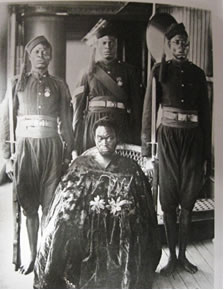
A recent visit to the British Museum confirmed what we have observed in previous years: many Western visitors to the museum have no specific interest in any particular Benin object, even if they visit the Sainsbury Gallery and look at the Benin Bronzes. They are mostly unaware of the looted Queen-Mother-Idia (“Iyoba”) ivory mask.
Have the hundred years of illegal retention of this mask had any effect on the knowledge and interest of the average Western visitor to the museum? It seems hardly any European visitor is even aware that the mask represents an important personality in Benin history. Most Western visitors are certainly unaware of her important and decisive role and influence in stabilizing the Kingdom of Benin
during the civil war at the end of the 15th Century, a crucial period in Benin history. Contrary to the propaganda of the Declaration on the Importance and Value of Universal Museums, Benin culture has not become part of European heritage and culture even though Benin artefacts have been illegally detained in Western museums for more than hundred years. (See also, Tom Flynn THE UNIVERSAL MUSEUM). The display of the ivory mask with many other looted Benin artefacts does not draw any particular attention to the Queen-Mother.
 Members of the nefarious British Punitive Expedition of 1897 posing proudly with their looted Benin artefacts
Members of the nefarious British Punitive Expedition of 1897 posing proudly with their looted Benin artefacts
Once we move from the Sainsbury Gallery to the Egyptian gallery and approach the Rosetta Stone, it becomes immediately evident that many visitors to the British Museum are aware of the importance of this artefact from Egypt which the British have also refused to return to Egypt despite multiple requests.
 Rosetta Stone, Egypt, now in British Museum, London, United Kingdom
Rosetta Stone, Egypt, now in British Museum, London, United Kingdom
But do they also know that the Rosetta Stone is part of Egyptian culture and not British culture? Are the visitors aware that there is no longer a need for scholars to decipher the language of the Rosetta Stone and that it would now be most appropriate to return it to its homeland, as the Egyptians have requested, so that it can be placed in a new museum of Egyptian culture?
Queen-Mother Idia clearly plays no role in the culture, imagination and thinking of Westerners. So why keep her captive in London when she would be a subject of veneration and reverence in her homeland Benin, Nigeria?
Why do the British Museum and the British Government still insist on keeping in Britain cultural artefacts of others, against the will of the owners?
So far, we have not come across any reasonable justification for such an attitude. Perhaps some have not yet recognized that the world has changed since the colonialist and imperialist epoch:
“The time has come when the British Museum should recognise the change in relative status between Britain and the rest of the world. We are no longer the imperial masters and increasingly need to build constructive working relationships as between equals.” Peter Groome (“It's time to gracefully relinquish the Rosetta Stone”, http://www.independent.co.uk).
Constructive and harmonious relations in matters of culture do not seem to matter to the British Museum otherwise we would not still be talking about the Parthenon/Elgin Marbles, Rosetta Stone and the Benin Bronzes. (See also Parthenon/Elgin Marbles, Rosetta Stone Benin Bronzes)
 Parthenon/Elgin Marbles, Athens, Greece, now in British Museum, London, United Kingdom.
Parthenon/Elgin Marbles, Athens, Greece, now in British Museum, London, United Kingdom.

Oba Ovonramwen, during whose reign the British looted the Benin Bronzes with guards on board ship on his way to exile in Calabar in 1897. The gown he is wearing hides his shackles. Photograph by the Ibani Ijo photographer J A Green. From the Howie photo album in the archives of the Merseyside Maritime Museum




 April 20: Cedi sells at GHS13.63 to $1, GHS13.06 on BoG interbank
April 20: Cedi sells at GHS13.63 to $1, GHS13.06 on BoG interbank
 Dumsor: I'm very disappointed in you for messing up the energy sector — Kofi Asa...
Dumsor: I'm very disappointed in you for messing up the energy sector — Kofi Asa...
 Dumsor: Instruct ECG MD to issue timetable and fire him for lying — Kofi Asare t...
Dumsor: Instruct ECG MD to issue timetable and fire him for lying — Kofi Asare t...
 Ashanti region: Road Minister cuts sod for 24km Pakyi No.2 to Antoakrom road con...
Ashanti region: Road Minister cuts sod for 24km Pakyi No.2 to Antoakrom road con...
 Train crash: ‘How could any normal person leave a car on rail tracks?’ — Frankli...
Train crash: ‘How could any normal person leave a car on rail tracks?’ — Frankli...
 Train crash: Driver of abandoned vehicle not our branch chairman nor secretary —...
Train crash: Driver of abandoned vehicle not our branch chairman nor secretary —...
 Kenya pays military homage to army chief killed in copter crash
Kenya pays military homage to army chief killed in copter crash
 US agrees to pull troops from key drone host Niger: officials
US agrees to pull troops from key drone host Niger: officials
 Mahama vows to scrap teacher licensure exams, review Free SHS policy
Mahama vows to scrap teacher licensure exams, review Free SHS policy
 Government will replace burnt Madina shops with a new three-story, 120-store fac...
Government will replace burnt Madina shops with a new three-story, 120-store fac...
